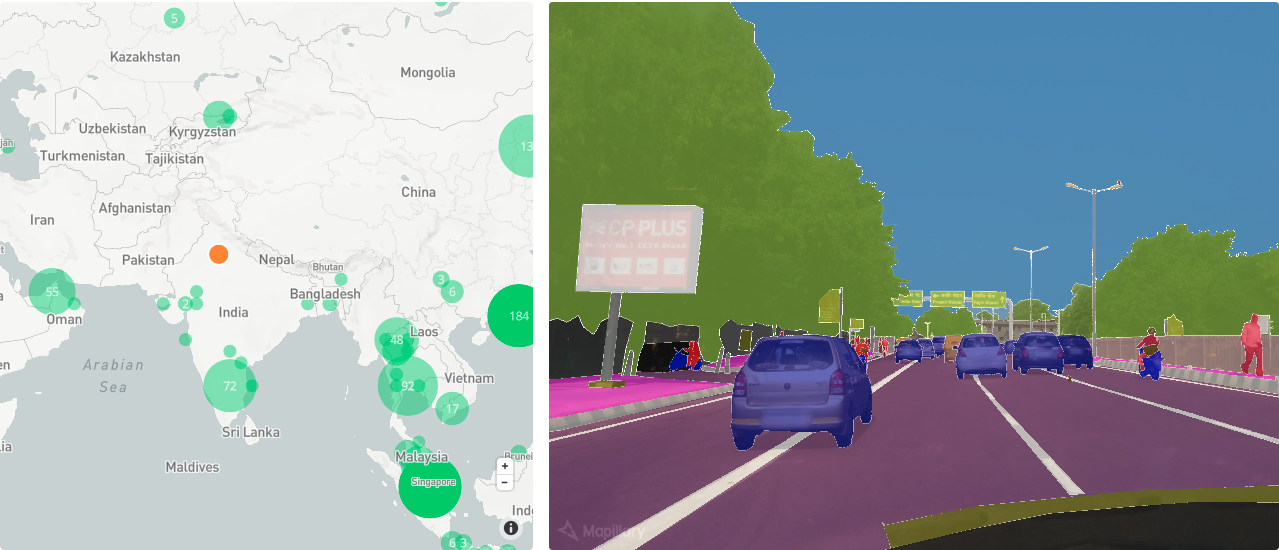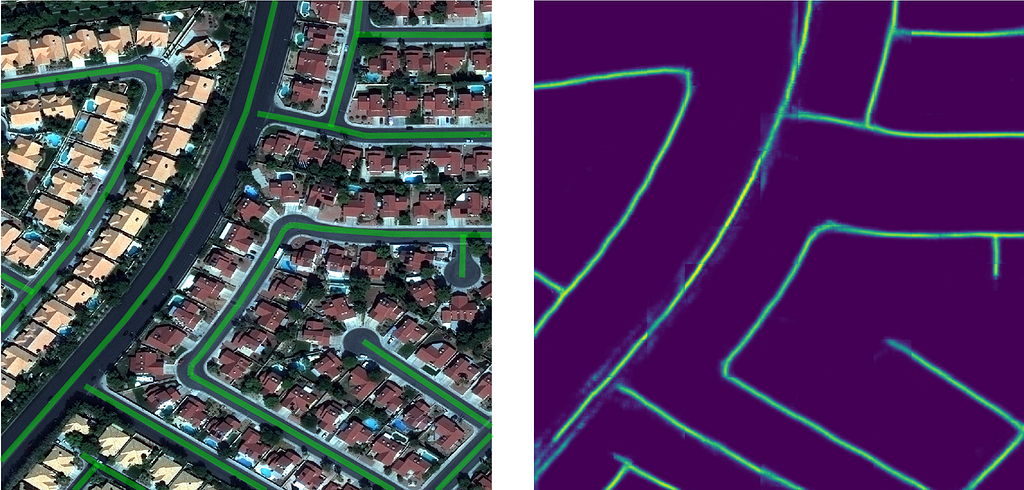44 in semantic segmentation pixel labels
How To Label Data For Semantic Segmentation Deep Learning Models? In semantic segmentation annotated images, each pixel in image belongs to a single class, as opposed to object detection where the bounding boxes of objects can overlap over each other. The main... Weakly Supervised Building Semantic Segmentation Based on Spot-Seeds ... Automatic building semantic segmentation is the most critical and relevant task in several geospatial applications. Methods based on convolutional neural networks (CNNs) are mainly used in current building segmentation. The requirement of huge pixel-level labels is a significant obstacle to achieve the semantic segmentation of building by CNNs.
learnopencv.com › applications-of-foregroundApplications of Foreground-Background separation with ... Jul 23, 2019 · Recall that semantic segmentation is a pixel-wise classification of the labels found in an image. The above figure shows an example of semantic segmentation. Each label is mapped to its corresponding color. The class “person” for example has a pink color, and the class “dog” has a purple color.

In semantic segmentation pixel labels
Learning from Pixel-Level Label Noise: A New Perspective for ... - DeepAI In this paper, we propose the first usage of learning with noisy labels for semi-supervised semantic segmentation task, which can be considered as a pixel-wise classification problem. However, relations between the pixel labels need to be adequately modeled, and very few studies have explicitly addressed this with unreliable and noisy labels. towardsdatascience.com › understanding-semanticUnderstanding Semantic Segmentation with UNET - Medium Feb 17, 2019 · The goal of semantic image segmentation is to label each pixel of an image with a corresponding class of what is being represented. Because we’re predicting for every pixel in the image, this task is commonly referred to as dense prediction. Note that unlike the previous tasks, the expected output in semantic segmentation are not just labels ... Understanding Images from Pixel Level with Semantic Segmentation - DeepLobe In semantic segmentation, every pixel of an image is associated with a class label as it treats multiple objects of the same class as a single entity. For example, in the above image, there are classes labeled as "camel", "man", "water", "sand", "sky" and any pixel belonging to any camel is assigned to the same "camel" class.
In semantic segmentation pixel labels. Understanding Semantic Image Segmentation and Its Use Cases Semantic segmentation splits an image into segments (classes), not leaving a single pixel unattributed. In our example from the Maldives above, there are three segments: the sun, the ocean, and the sky. Labelers use different colors to match each, especially minding the borders. This way, every single pixel belongs to a class and has its color. Semantic Segmentation Using Pixel-Wise Adaptive Label ... - PubMed Semantic Segmentation Using Pixel-Wise Adaptive Label Smoothing via Self-Knowledge Distillation for Limited Labeling Data To achieve high performance, most deep convolutional neural networks (DCNNs) require a significant amount of training data with ground truth labels. cnvrg.io › semantic-segmentationSemantic Segmentation - The Definitive Guide for 2021 - cnvrg The process of linking each pixel in an image to a class label is referred to as semantic segmentation. The label could be, for example, cat, flower, lion etc. Semantic segmentation can be thought of as image classification at pixel level. Therefore, in semantic segmentation, every pixel of the image has to be associated with a certain class label. Semantic vs. Instance vs. Panoptic Segmentation - PyImageSearch The difference between semantic vs. instance vs. panoptic segmentation lies in how they process the things and stuff in the image. Semantic segmentation studies the uncountable stuff in an image. It analyzes each image pixel and assigns a unique class label based on the texture it represents. For example, in Figure 1, an image contains two cars ...
PDF Semi-Supervised Semantic Segmentation Using Unreliable Pseudo-Labels The crux of semi-supervised semantic segmentation is to assign adequate pseudo-labels to the pixels of unlabeled images. A common practice is to select the highly confident predictions as the pseudo ground-truth, but it leads to a problem that most pixels may be left unused due to their unreliability. We argue that every pixel matters to the model What exactly is the label data set for semantic segmentation using FCN? In semantic segmentation, the label set semantically. Which mean every pixels have its own label. For example, we have 30x30x3 image dimensions, so we will have 30x30 of label data. Every pixels in... How to to drop a specific labeled pixels in semantic segmentation For semantic segmentation you have 2 "special" labels: the one is "background" (usually 0), and the other one is "ignore" (usually 255 or -1). "Background" is like all other semantic labels meaning "I know this pixel does not belong to any of the semantic categories I am working with". Semantic Segmentation Using Pixel-Wise Adaptive Label ... - ResearchGate Here, we propose a new regularization method called pixel-wise adaptive label smoothing (PALS) via self-knowledge distillation to stably train semantic segmentation networks in a practical...
Label Pixels for Semantic Segmentation - MathWorks Label Pixels for Semantic Segmentation The Image Labeler , Video Labeler, and Ground Truth Labeler (Automated Driving Toolbox) apps enable you to assign pixel labels manually. Each pixel can have at most one pixel label. The labels are used to create ground truth data for training semantic segmentation algorithms. Start Pixel Labeling arxiv.org › pdf › 2203Semi-Supervised Semantic Segmentation Using Unreliable Pseudo ... The crux of semi-supervised semantic segmentation is to assign adequate pseudo-labels to the pixels of unlabeled images. A common practice is to select the highly confident predictions as the pseudo ground-truth, but it leads to a problem that most pixels may be left unused due to their unreliability. We argue that every pixel matters to the model en.wikipedia.org › wiki › Image_segmentationImage segmentation - Wikipedia Instance segmentation is an approach that identifies, for every pixel, a belonging instance of the object. It detects each distinct object of interest in the image. For example, when each person in a figure is segmented as an individual object. Panoptic segmentation combines semantic and instance segmentation. Like semantic segmentation ... Multi-layer pseudo-supervision for histopathology tissue semantic ... The basic idea of this model is to use patch-level classification labels to automatically generate pixel-level semantic segmentation masks, and then use the generated pseudo masks to train a semantic segmentation model. Our proposed model contains a classification phase and a segmentation phase.
Semantic segmentation | semantic segmentation services Semantic Segmentation is understanding an image at the pixel level and is used in computer-vision based applications that require high accuracy. This classification is when there are more than two categories in which the images can be classified. This means an image belongs to more than one category and involves the prediction of multiple ...
🚀 A PyTorch implementation of MobileNetV3 for real-time semantic segmentation, with state-of-the ...
Augment Pixel Labels for Semantic Segmentation - MathWorks Semantic segmentation training data consists of images represented by numeric matrices and pixel label images represented by categorical matrices. When you augment training data, you must apply identical transformations to the image and associated pixel labels. This example demonstrates three common types of transformations:
In-depth Guide to Semantic Segmentation - AIMultiple Semantic segmentation architecture mainly consists of an encoder and decoder network. Encoder takes image data as an input. It prepares image data for the usage of the decoder. It processes image data to extract statistical properties of the image such as the number of pixels. These features help to label and locate objects in a further step.

Pytorch implementation of Semantic Segmentation for Single class from scratch. | by Shashank ...
13.9. Semantic Segmentation and the Dataset - D2L Different from object detection, semantic segmentation recognizes and understands what are in images in pixel level: its labeling and prediction of semantic regions are in pixel level. Fig. 13.9.1 shows the labels of the dog, cat, and background of the image in semantic segmentation.
Label Pixels for Semantic Segmentation - MATLAB & Simulink Label Pixels for Semantic Segmentation The Image Labeler , Video Labeler, and Ground Truth Labeler (Automated Driving Toolbox) apps enable you to assign pixel labels manually. Each pixel can have at most one pixel label. The labels are used to create ground truth data for training semantic segmentation algorithms. Start Pixel Labeling
An overview of semantic image segmentation. - Jeremy Jordan Common datasets and segmentation competitions Further reading More specifically, the goal of semantic image segmentation is to label each pixel of an image with a corresponding class of what is being represented. Because we're predicting for every pixel in the image, this task is commonly referred to as dense prediction.



Post a Comment for "44 in semantic segmentation pixel labels"